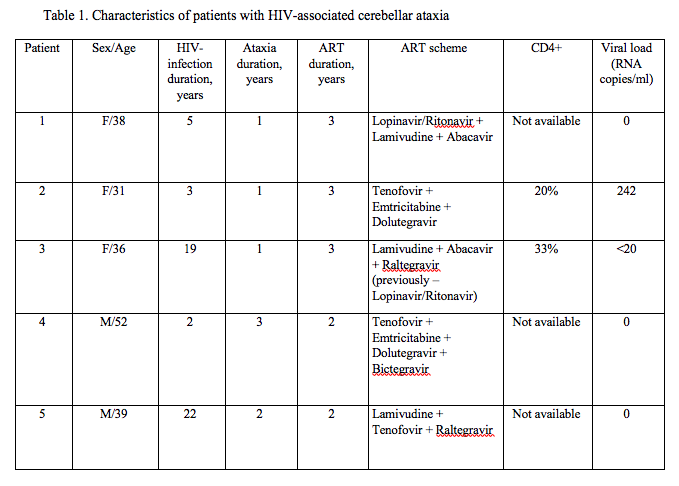Category: Ataxia
Objective: To evaluate the effect of antiretroviral therapy (ART) on the course of HIV-associated cerebellar ataxia.
Background: Cerebellar ataxia is a rare manifestation of HIV infection. The precise pathogenesis of cerebellar degeneration and ataxia is still unclear. Possible pathogenetic mechanisms include cytotoxic effect of the virus, microglial and macrophage activation and neuroinflammation, autoimmune cerebellar damage due to infection, neurotoxic effect of antiretroviral drugs.
Method: Five patients with HIV-associated cerebellar ataxia were examined. Autoimmune, deficient and other causes of ataxia, as well as opportunistic infections, multiple system atrophy and frequent forms of hereditary spinocerebellar ataxias were excluded. Scale for the Assessment and Rating of Ataxia (SARA) and brain MRI study were performed. Viral load, CD4+ cell count and ART scheme were analyzed.
Results: All cases were sporadic. In four patients, the onset of ataxia was after 4 years (from 2 to 20 years) from the diagnosis of HIV infection, on average 2 years after the start of permanent ART. Patient №4 developed cerebellar ataxia 1 year before serological confirmation of HIV infection and ART initiation. Clinically, cerebellar ataxia, oculomotor dysfunction, scanning speech were noted in all patients, pyramidal signs – in 4 patients, dysphagia – in 2 patients. Brain MRI study revealed cerebellar degeneration in all cases. The median score on the SARA scale was 12/40 points (from 11 to 18 points). Against the background of ART, an undetectable level of viral load was achieved in three patients, which indicates a high effectiveness of therapy. Nevertheless, in all cases the symptoms of ataxia were slowly progressive, which may indicate the current degenerative process. All patients received different schemes of ART [table 1], thus there is no evidence that ataxia may be associated with the neurotoxic effect of antiretroviral drugs in these cases.
Conclusion: Cerebellar degeneration can develop even after achieving stable remission on the background of ART, therefore, it is necessary to initiate ART as early as possible, regardless of CD4+ cell levels, viral load and the presence of clinical symptoms.
To cite this abstract in AMA style:
L. Brsikyan, E. Nuzhnyi, е. Fedotova, S. Illarioshkin. Course of HIV-associated cerebellar ataxia on the background of antiretroviral therapy: clinical cases of 5 patients [abstract]. Mov Disord. 2023; 38 (suppl 1). https://www.mdsabstracts.org/abstract/course-of-hiv-associated-cerebellar-ataxia-on-the-background-of-antiretroviral-therapy-clinical-cases-of-5-patients/. Accessed December 29, 2025.« Back to 2023 International Congress
MDS Abstracts - https://www.mdsabstracts.org/abstract/course-of-hiv-associated-cerebellar-ataxia-on-the-background-of-antiretroviral-therapy-clinical-cases-of-5-patients/

